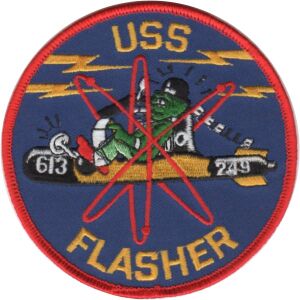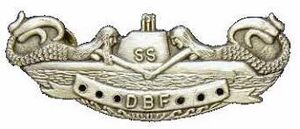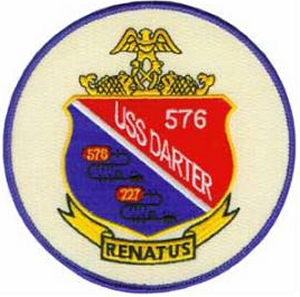Main Page: Difference between revisions
No edit summary |
No edit summary |
||
| Line 8: | Line 8: | ||
{| class="wikitable" <span style="color:#00008B"> | {| class="wikitable" <span style="color:#00008B"> | ||
|+ | |+ | ||
!03-May-2023 L-Boats | !03-May-2023<br>L-Boats | ||
!03-May-2023 | !03-May-2023 | ||
!03-May-2023 | !03-May-2023 | ||
Revision as of 19:46, 7 May 2023

Latest Updates
| 03-May-2023 L-Boats |
03-May-2023 | 03-May-2023 | 03-May-2023 | 11-Oct-2022 |
|---|---|---|---|---|
 |
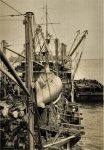 |
 |
 |
 |
| USS O-3 & O-2 Groton Ct. c1921 | USS B-1 before launch Cavite PI 1915 | USS O-3 & O-2 Groton Ct. c1921 | Photo from the Library of Congress Collection | A Good and Favorable Wind A Book by PigBoats.COM |
An important note about submarine names
About PigBoats.COM
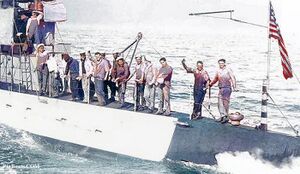
I was struck by this statement pulled from another submarine related page called Sweet Bird Of Youth.
These sailors were the boys down the street, around the corner, out on the farms, the high school football heroes and, yes, even the geeks of their time, but they became one of the elite, one of that 1% that made the cut and became "Qualified in Submarines". They were, and still are, the best of the best of the United States Navy.
It is important to remember that the submarines were just steel and machinery. It was the men who brought them to life and made them live. It is the men that gave them the romance, the mystery and the mystique.
I have included a number of first person accounts on a some of the pages of what life was like aboard an "S" or "R" or even a "K" boat. There is also an account of what it was like being bombed on Sealion at Cavite Harbor in December, 1941. All this is most valuable since the men who sailed these boats are rapidly making their own "eternal patrols". Preservation of these verbal images is important.
Sailors, rest your oar! You stand relieved, we have the watch. ...and thank you!What is a Pigboat?
But, where did the term come from and what did it mean to be a Pigboat sailor? Our earliest subs were built without periscopes. In order to see where they were going, they had to frequently pop to the surface so that the captain could see through small deadlight windows built into the access trunk that stuck up above the deck. After a brief check of his bearings, the captain would take the sub back down and continue on their way. Legend has it that amused surface ship sailors (who thought of the early subs as nothing more than toys) thought this repeated surfacing and diving looked very much like the action of a swimming porpoise. Old time sailors referred to porpoises as “Sea-pigs”.
The early subs were tiny when compared to their cruiser and battleship brethren. Because of their limited range, for long voyages they were hauled out of the water and carried on the deck of larger ships. Any small craft that could be carried on a larger ship was called a “boat”. The combination of these terms led them to be called “Pigboats”.

It became an even more appropriate title when the conditions inside the boats were considered. There was little or no fresh water and the sanitary facilities consisted of an open bucket. Ventilation was poor at best and the air was permeated with a combination of gasoline or diesel fumes, ozone, smoke from frequent electrical shorts, human sweat and sea spray. Combine that with stifling heat and humidity and you can imagine what our first submariners must have looked and smelled like when they returned from a run at sea. Until the late 1920’s, there was also no viable method for escaping from a disabled sub. If the boat suffered even a minor accident, the usual outcome was death for the entire crew.
How did these men cope with these arduous conditions? Frequent and intense swearing (in and of itself an unheralded stress reliever), biting sarcasm, bawdy humor, the spinning of barely believable and outlandishly humorous sea stories, and locker room style practical jokes all served as a relief valve venting the frustrations and stresses they faced. When they returned from sea, the Pigboat sailors lived life as if there was no tomorrow, their drinking and partying escapades becoming the stuff of legends. It was a reaction to being locked up in a steel tube deep under the sea: you were restless and eager to move around in the open air again and exhilarated that you had made it back alive.
It is common that when a group of diverse people are thrown together under perilous and difficult conditions a bond of sorts will develop between them; a unique type of fraternity born out of a shared dangerous experience, stronger than any brotherhood. Due to the boats’ small size and unique nature of operation every man aboard also had to know the job of the all the others. The rigorous and vital process of learning every system, every valve, lever, and gauge became a test of not only your mental acuity, but of your character as well. If you passed the test, you were awarded the highly coveted “Dolphins” insignia and you became a real submariner. The friendship that developed between you and your shipmates was like no other in the Navy. Your buddy may have been rude, crude, and socially unacceptable and you wouldn’t trust him near your sister, but by god you would go to the end of the earth for him. You were immensely proud of your boat and your shipmates and you literally wore this on your sleeve in the form of your embroidered Dolphins.
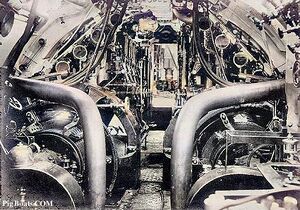
What else made men want to be Pigboat sailors? Contrary to popular belief, our first submarines were by no means primitive. When taken in the context of the times, they were vessels of incredible ingenuity and sophistication which pushed the existing technological envelope to its limits. It is apt to compare them to the early manned spacecraft of the great Space Race; they were just as advanced a concept and because of that, just as dangerous to operate. Like the spacecraft of the 1960s Project Mercury they represented a challenge: did you have the manly, devil-may-care machismo that it took to push the envelope and make it look easy? Technical competency was an absolute must, and it went hand-in-hand with solid professionalism. This was a potent siren song for men looking for a challenge.
Forward thinkers in the early 1900’s also understood that submarines represented the cusp of a revolution in naval warfare; a paradigm shift in strategy and tactics. Submarines were a virtually undetectable warship that fired a deadly weapon that there was little defense against. This made the battleship sailors who dominated the Navy at that time very nervous, and it drew professional sailors to volunteer for this pathfinding service.
It took a while, but eventually the surface sailors began to see submariners differently. Amongst themselves, they may have looked down their noses at their smelly and socially obnoxious brethren, but deep inside they respected their technical know-how and their fearlessness in the face of danger. When they said, “Look, here comes a Pigboat!” their voices dripped disdain, but if you listened close enough you would pick up the hidden admiration... and the respect.
The Submarine Tradition
New Book Release
A Good and Favorable Wind Co-written by David L. Johnston & Ric Hedman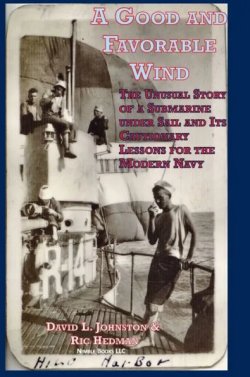
PigBoats.COM is pleased to announce the publication of our first book: "A Good and Favorable Wind", written by co-webmasters Ric Hedman and David Johnston.
This is the true story of the USS R-14 (SS-91) and a voyage that she took in May of 1921. Assigned to a search and rescue mission in an area east of the Big Island of Hawaii, the R-14 was subjected to a set of circumstances unique in the annals of the U.S. Submarine Service. If the crew is to return safely to port they must display superb leadership, inspired out-of-the-box problem solving, innovation, and perseverance. The aftermath of the incident examines the hows, the whys, and the lessons learned, and provides a primer to today's Navy in how to dispense fair and even-handed discipline.
This is a project over 10 years in the making, and has been a labor of love for Ric and Dave. We are justifiably proud of our work and we hope you will give it a read. It is available now online at Amazon and Barnes & Noble, and should be on the shelves in bookstores before Christmas 2022.
Enjoy! Thank you.
Acknowledgements
I would like to especially thank Mr Roland Goodbody, Manuscripts Curator, Milne Special Collections & Archives at the University of New Hampshire Library and his staff and the University of New Hampshire for all their cooperation and kindness in helping me in this endeavor.
All photos that are from the Milne Special Collections, University of New Hampshire Library, Durham, N.H. are their property and may not be reproduced without their permission.
I would also like to thank Wendy Gulley, Curator of The US Navy Submarine Force Museum Library in Groton, Ct. for her kind indulgences in letting me use their archive.
Photos credited to the people who submitted them are their property and may not be copied or reproduced without their permission unless the original photos come from the public domain such as The National Archives or the United States Navy.
Your PigBoats.COM Staff
Webmaster TN(SS) Richard C. "Ric" Hedman, USN, a native of Washington state, joined the Navy in 1964. He put into commission the nuclear submarine USS Flasher (SSN-613) and took her to sea on her initial sea trials in the Atlantic and subsequent patrols in the Pacific. In 1968 he transferred to the Naval Reserve and was sent to the diesel submarine USS Cusk (SS-348) in 1969 as part of his annual Reserve training before mustering out of the Navy to pursue civilian careers in 1970. He is Qualified in Submarines. Ric has been the webmaster of PigBoats.COM since 1999.
Webmaster DCC(SS/SW) David L. "Dave" Johnston, USN (Ret.) is a native of Michigan and first joined the Navy in 1983. He joined the crew of the USS Darter (SS-576), forward deployed to Sasebo, Japan and patrolled the western Pacific for three years. After a break of nearly 15 years, he rejoined the Navy in 2001 and finished out a 21 year career, retiring in 2019. Dave has also served on minesweepers and destroyers in addition to active duty service to the Navy Reserve. He is Qualified in Submarines and Surface Warfare. Dave has been associated with PigBoats.COM since 2001.
Page created by:
Ric Hedman & David Johnston
1999 - 2023 - PigBoats.COM©
Mountlake Terrace, WA, Norfolk, VA
webmaster at pigboats dot com
